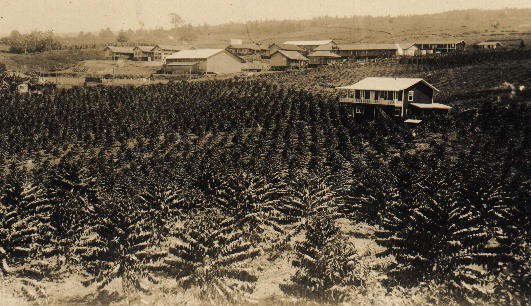~ Konawaena High School Road ~
From the Collections of Kona Historical Society.
Here is a marvelous photo of the way Kona mauka looked in the middle of the 20th century. We are perched on a ladder or in a tree (how did the photographer get this shot?) in the ahupua`a of Onouli, South Kona, at an elevation of 1,500 feet above sea level. Mamalahoa Highway is off to the left, as is Christ Church Episcopal, out of the picture, and we are gazing north-east at the distant slope of W.H. Greenwell’s ranch lands, dotted with ohi`a trees and cross-crossed by stone walls.
However, this photo is not about cattle; it is all about coffee. In the foreground is Sanzo Ikeda’s newly planted coffee farm, his rows of glistening coffee trees as neatly laid out as a green chess board. Built to overlook his coffee land is a two story house with plenty of room to shelter his family of eight children. Just to the right of the home is a small white roofed structure that looks suspiciously like an out house. There must be a water tank tucked nearby, for Kona had no public water system until nearly 1960. The newly planted coffee land to the right and mauka of the Ikeda home belonged to Mr. Yonemura, another optimistic Japanese man who was betting his future on coffee. How well kept and tidy these farms appear, flourishing on rainfall and Kona sunshine.
Beyond the coffee land is Konawaena School. Originally a Grammar School, this sprawling complex with its original wooden buildings saw its first senior class graduate in 1925. As the first public high school in the entire district, students from Honomalino to Pu`uanahulu came to Konawaena for an education. The old gymnasium is clearly visible, perched above Julian Yates playfield, both places well used by Konawaena Wildcats who played topnotch baseball and basketball. The old Coffee Schedule was in full force at this time, the only school schedule in the Territory dictated by an agricultural crop. With no classes from mid-August to early November, schoolchildren were available to help their parents pick coffee. Many a Kona boy’s football dreams were effectively squashed by this unique schedule finally abandoned in 1969.
I attended Konawaena Elementary and Intermediate School from 1957 to 1964, a time of transition during which the first of these original wooden buildings were torn down and replaced by sturdy new concrete and cinderblock designs. I remember the old cafeteria with its mural of red anthuriums painted on a pale green interior wall, replaced in the mid-1950s by the “new cafeteria” which is now over 50 years old!
The fantastic May Day programs put on at Julian Yates Field were absolutely the high point of my early school years. The May Day Court - King, Queen, flower girls and pages, island princes and princesses - were all beautifully dressed in colorful outfits and bedecked with flowers. In those years, maile grew rampant in Kona’s damp forests and the idea of purchasing a maile lei from a florist shop was utterly unheard of. Let’s face it – Kona mauka did not even have a florist shop. Everyone wore lei on May Day, most of them strung from plumeria or crown flowers, but Mauna Loa lei fashioned from Tom Kadooka’s vanda orchids grown in Kainaliu were prized showstoppers in those years. Little girls got to put on lipstick – bright red or orange - if their class was doing a hula or Filipino dance. In third grade, our class did a Chinese dance, and we wore braided pigtails made out of our teacher’s (Mrs. Helen Greenwell’s) discarded stockings which we dyed black and fashioned into queues. I can recall the gorgeous Chinese pajama outfits worn by my Japanese female classmates that day, vibrant Oriental patterns in silk and rayon. I wore some pale blue cotton outfit and I felt quite the Plain Jane. However, I think all the girls got to wear lipstick that day and feel fancy. The boys probably hated the entire experience!
In case you haven’t noticed, it’s coffee season in Kona. Word of mouth has it that the crop is a good one, so despite borer beetles, election year politics and VOG, farmers are up to their ears in coffee beans. The Kona Coffee Festival is geared up to start on November 2nd. To get everyone in the mood, KHS is hosting a FREE open house at Uchida Farm on Saturday, October 20th. If you have never wandered through the old Uchida home and enjoyed its simple early 20th century charm, you should jump at this opportunity. After all, coffee has played a big part in Kona’s history for well over 170 years, impacting everything from the look of the landscape to the economic health of the entire district.
When coffee’s perking, people are working, kids aren’t shirking, and trouble’s not lurking!
Aloha no!

